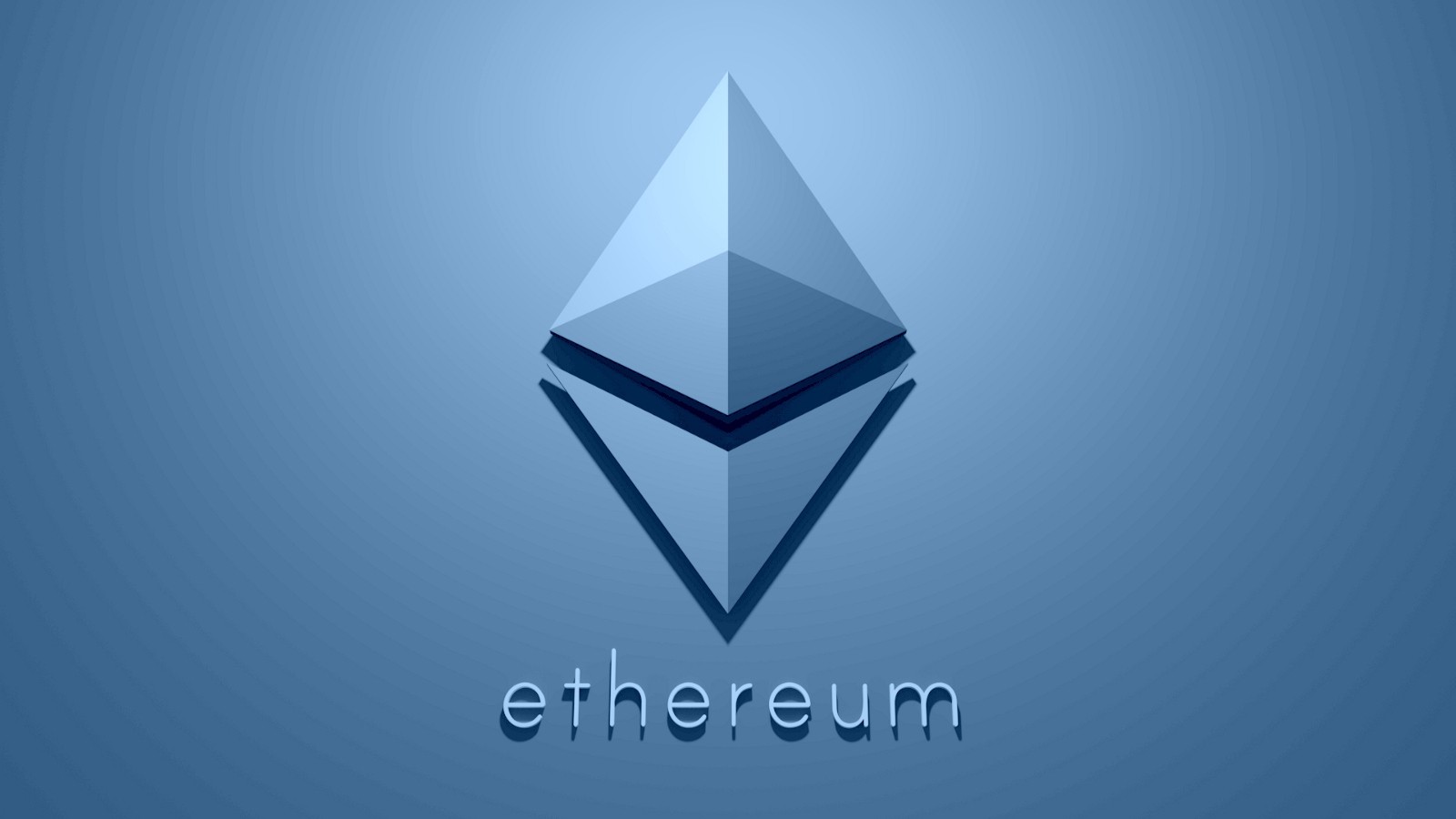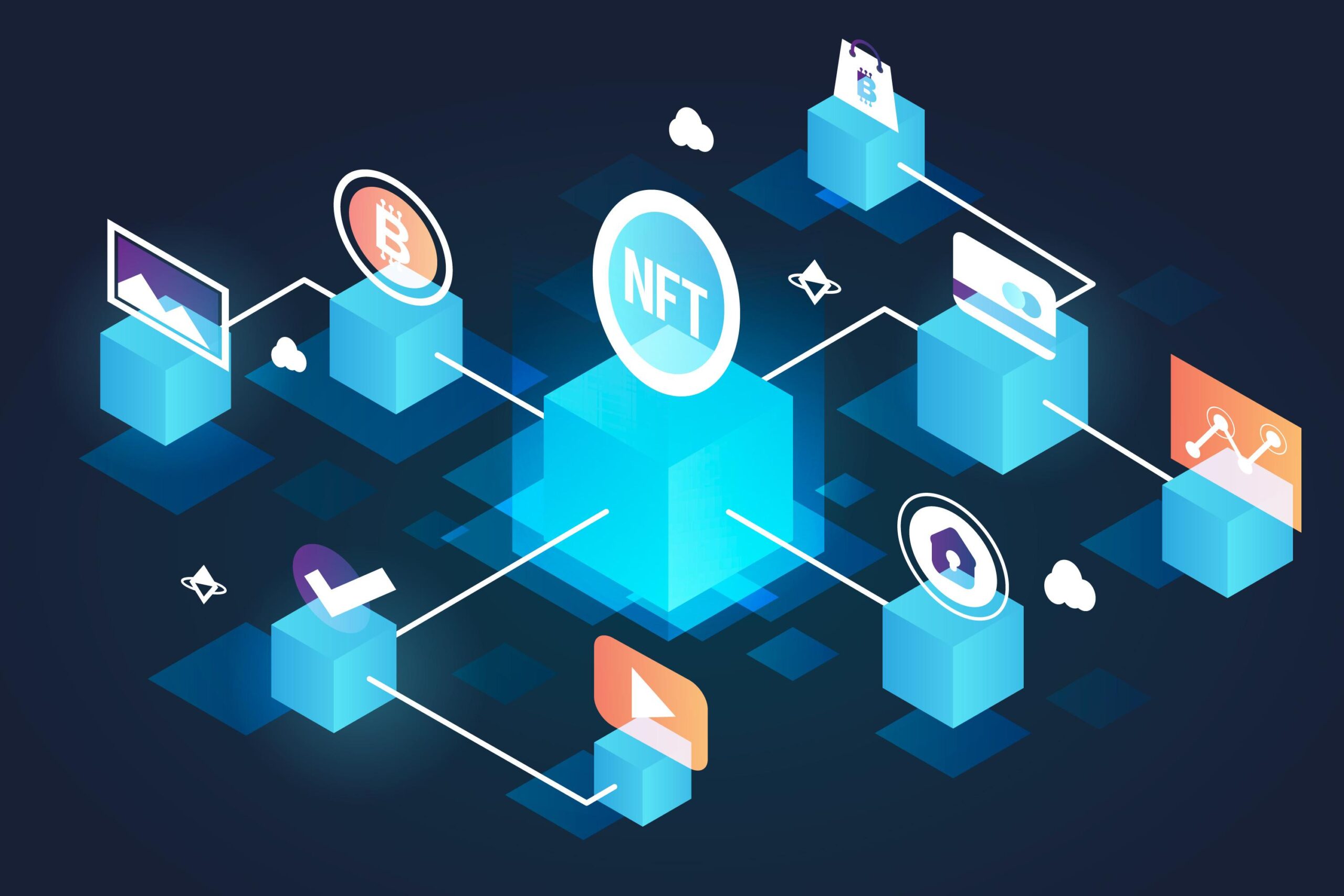In this Telegram AMA recap, you’ll find insights about the Casper project. In an event hosted by Lucky from MEXC, you will meet Ralf Kubli (Board Members of Casper Association) Cliff Sarkin (Chief of Strategic Relationships for CasperLabs)

Cliff Sarkin:
We are excited to share! By way of education, I am an attorney, but I was never meant to be a lawyer. After a few unhappy years practicing law, I joined my first start up (this is back in 2010), and I’ve never looked back. I love to build tech companies, and I do everthing on the business side, like raising money, putting together important deals, business development, etc. I had some nice successes before blockchain, including one exit to Microsoft. But by far the biggest and most exciting project I’ve had a chance to be a part of is Casper. I was fortunate enough to meet the founding team at CasperLabs in the summer of 2018, and I offiically joined in January 2019.
Ralf Kubli:
Hi, I am Ralf Kubli, one of the Board Members of Casper Association. My professional career has been spent both in large companies and in startups. I began in Web2 building websites and browsing the world, when everything was open and accessible. I then spent 18 years in large companies in management positions. I first came across Blockchain in 2016 and then joined a Venture Capital firm, and now support several Web3 organizations as a board member.
The Casper Association is the not-for-profit, Switzerland-domiciled organisation which is responsible for overseeing the network and supporting its organic evolution and continued decentralisation. In essence, we are the steward of the open source protocol, and as such, we advance the development of the network with the core team at CasperLabs and other parties which can contribute to the protocol. Membership in the Association is comprised of the independent validators which run nodes on the Casper Network. The Association currently has 12 full time staff members.
Questions from the community:
Lucky Q1. Cliff, can you explain what Casper is and how the network is differentiated from other layers 1 blockchains?
Cliff Sarkin: Yes, absolutely. The Casper Network is a layer 1 blockchain and Turing-complete wasm based smart-contracting platform, backed by the only operational CBC-Casper Proof-of-Stake (PoS) consensus algorithm – known as Highway. Casper is a permissionless, decentralized, public blockchain.
The Network has been built from the ground up for enterprise and developer adoption. Fundamentally, any commercial organization and any size project that is seeking to build an application using technology is going need control over their on chain contracts, support their customers, and some guarantees that the protocol will continue to adapt and evolve as their needs change. Casper allows enterprises and developers to integrate blockchain technology into their existing systems and development processes seamlessly. Many other Layer 1 protocols believe that a full replacement of the technology stack is in order in order to make these systems “blockchain ready” or “blockchain centric.” We belive that replacement of existing systems is not feasible. Rather, software is governed and developed incrementally, and the Casper technology provides for this, without sacrificing security. This is possible because of the capabilities that the Casper blockchain provides.

As a pure PoS network, Casper supports a variety of network installations. An enterprise can choose to use a hybrid deployment of Casper or use the mainnet. Key properties of how the blockchain runs can be configured at startup, and modified by a seamless upgrade process. This applies to all deployments of Casper, including mainnet. It is completely possible to move from a private, to a hybrid, to a consortium or even public network without having to restart the network. Enterprises do not need to feel locked into a particular deployment of the blockchain, they have the flexibility to include more participants as their needs change.
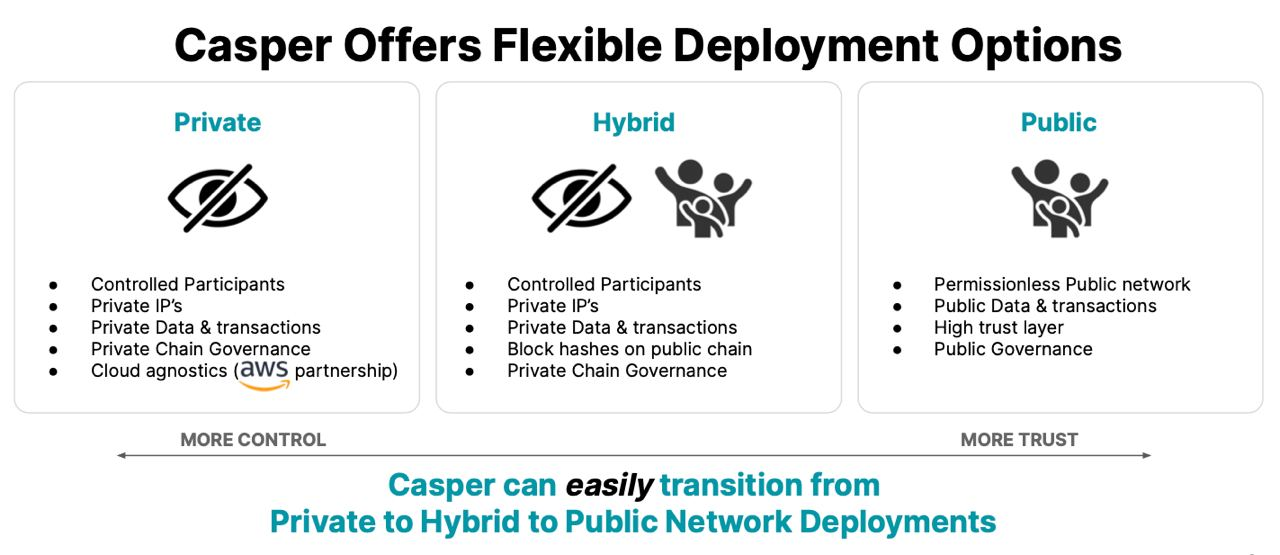
Lastly and importantly, Casper has also been built for sustainability, with a modular architecture that allows for swapping out of consensus protocols, execution environments, and crytpographic encryption schemes. This is extremely important for the long term health of the protocol. As new research and developments take place in these areas, Casper is well positioned to take advantages of future innovation in the space. Because of all of this, enterprises and blockchain native companies alike are partnering with us to build on Casper.
Lucky Q2. moving to the Casper Association, will you please tell us what are the Association’s primary objectives currently?
Ralf Kubli: Sure. The Casper Association in 2022 is focused on four major areas: network growth/upgrades, tokens on Casper, NFTs, and R&D. Please allow me to elaborate on each…
1. Casper Network and ecosystem development through coordinated network upgrades, documentation resources and educational material. Validators and node operators will be well informed and have access to required resources. Here is a look at just how robust the Casper Ecosystem already is!
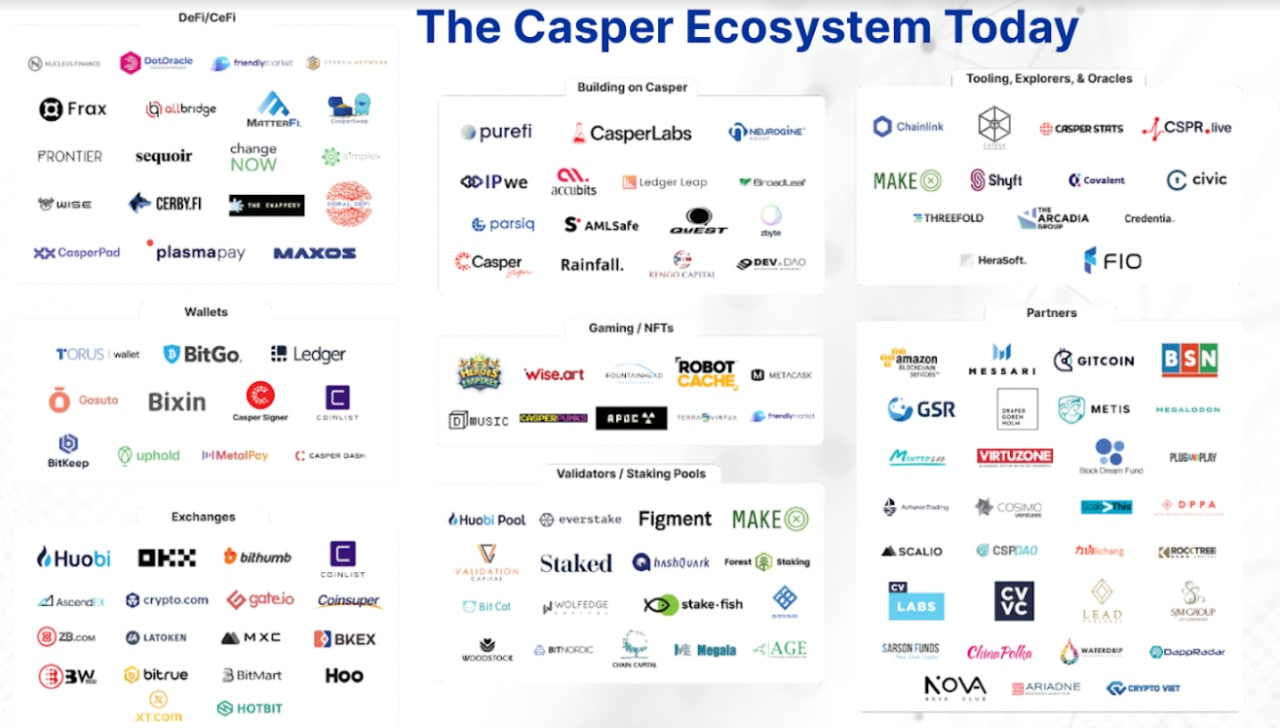
2. The enablement of tokens built on top of Casper (similar to ERC20 tokens on Ethereum but with better security & performance), with standards-based token issuance, as easy to use as ERC-20, tokens can easily be created on Casper with better security and performance, and the mechanisms exist to efficiently bring dApps from Ethereum & other chains.
3. Supporting the growth of the NFT Ecosystem on Casper. We firmly believe NFTs will fundamentally change how economies function and drive structural innovation in ways not yet imagined. The Casper Network will be a major player in this future infrastructure due to functions native to the Casper technology which are not available on other blockchains.
4. Research and Development – The Association is tackling challenges that blockchains face and ensures that the Casper Blockchain is ready for the future. Ensuring decentralization, readiness for quantum computing, and overall incentive structures are critical for the future.
Lucky Q3. you mentioned the Casper Blockchain was built and is optimized for developer adoption. Can you elaborate on what makes the Casper Network more developer-friendly and enterprise-grade than others?
Cliff Sarkin: Absolutely. To start, many blockchains require propriety programming languages knowledge to build on them. For example Ethereum uses Solidity while Cardano requires knowledge of Plutus. We should make it easier – not harder – for Web2 developers to becomne blockchain developers. To do this, Casper supports Rust and AssemblyScript where most programmers with experience in existing programming languages will be able to build on Casper.
Here are several more developer-friendly features:
– Contract execution based on WASM lets developers use any language of their preference, rather than having to learn a new language to get started.
– Before blockchain, all software was built in an IDE (Integrated Development Environment – like Visual Studio). Casper contracts can be authored, compiled, run and tested from within this environment. This is like the original HardHat, but for all software
– Permissioned references – it’s possible to share data securely across contracts.
– Event emission – blockchain event data & transaction information is streamed from the node in a push mechanism rather than a pull mechanism.
– Casper is the only blockchain with on chain package management – when a contract is created on chain, it is ‘installed’ – at which point a new package is created.
– Powerful accounts with weighted keys – this enables distributed control and management over contracts and accounts by delegating accounts to one another, granting weights for deployments, and flexible key management.
– In contract permissions where multi-signature can be applied at the contract level, enabling permissions around specific contract functions themselves.
These are only a few of the notable features in Casper. There are many more. And they are host side. Which makes contracts simpler and more gas efficient. Casper was created for serious developers that want to build real world solutions.
Lucky Q4. What is Casper doing in the areas of NFTs and DeFi?
Cliff Sarkin: Well, we definitely understand the importance of both of these growing segments within the blockchain ecosystem. NFT’s have broad application – I see the world as being full of non-fungible items. You cannot break up a chair into 100 pieces and use those pieces to purchase food – for example. It’s non-fungible. NFT’s are excellent for representing the world around us – on the blockchain.
We see NFT’s as having very high utility in Enterprise to track unique items, for tickets, coupons, KYC, and so on. This is why there is so much focus on NFT based contracts. Casper’s CEP-78 contract uses a factory pattern, it can be used to install many different types of NFT contracts. Casper NFT’s offer optional mutability of on chain metadata, enabling the NFT’s to track changes to the state of it’s associated asset. Casper contracts function like ordinary software, it’s up to the contract author to determine what the upgrade pattern is. Because the VM (virtual machine) on Casper is purpose built, it is possible to consider bringing the NFT standard host side, making the transactions faster, lighter and more gas efficient.
There are multiple marketplaces already integrating with the Casper Network; Metacask (https://metacask.com/), Wise.Art (https://platform.wise.art/), Friendy.Market, CasperNFT.market and even one of our enterprise clients, IPwe (https://ipwe.com/), utilizes our NFT Technology.
I’ll let Ralf discuss some of the DeFi implementations that are being built on the network as well.
Ralf Kubli: Thank you, Cliff. We recognize that DeFi is important to bring liquidity and utility to the network. DotOracle has launched the first bridge on Casper – an AnySwap fork that connects Casper to to BSC, Polygon, ETH, AVAX, FTM and other EVM compatible chains. You can find the bridge at https://bridge.dotoracle.network. Ferrum Network team is also launching whitelabeled bridges for BSC, ETH and Polygon- and these will be releasing shortly.
The first DEX is live at https://friendly.market – and 3 other DEX’s are preparing for launch (CasperSwap, WiseSwap, Swappery) in the coming months.
There are wrapped stablecoins and wrapped assets available in Friendly Market already.
There will also be wrapped stablecoin integration via the DotOracle bridge, Change.Now and eventually a native FRAX implementation being developed on Casper.
It’s possible to observe all the contracts on mainnet at https://cspr.live/contracts – 151 contracts on mainnet, and 4,800 contracts on testnet. A lot of building is taking place, with production releases around the corner.
Here is a snapshot of the DeFi projects and infrastructure being built.

For an easy user experience, the Casper Network is supported by Torus Wallet (accessible at https://casper.tor.us/), which enables users to interact with Casper without having to worry about key management. Upohold (accessible at https://uphold.com/) is also a popular onramp and venue to access Casper CSPR.
Lucky Q5. For those in our community who know about other layer 1 blockchains like Ethereum, Tezos, Algorand, Cosmos, Hashgraph, etc), can you explain how Casper is different and in what ways its superior?
Cliff Sarkin: Yes, sure. Casper is unique in that it is the first provably live and provably safe version of CBC Casper ever built. In that way, it is arguably the only fully decentralized, highly secure, and scalable Proof of Stake blockchain – one that does not sacrifice security for performance.
This is an extremely important point… In the pursuit of throughput, many protocols have sacrified security. The blockchain must not sacrifice security for performance. Security is valued more than performance – and one need not look beyond Bitcoin and Ethereum to see this.
While we do stand alone in this, the Casper blockchain is a layer one chain and thus, in the broad sense, any layer one could be considered competition, including by not limited to:
– Hyperledger Fabric & Corda: enterprise-focused chains but only permissioned versions and lacking critical features which Casper has built.
– Hedera Hashgraph: highly centralized and permissioned, liveness is only statistical, not provable.
– Solana: highly centralized, unstable (several downtimes) – team is not security focused
– Polygon: not a layer 1, EVM based smart contracts, and solidity developers are hard to recruit and retain for enterprises.
– Fantom: EVM-based smart contracting engine. Solidity developers are hard to recruit and retain for enterprises.
– EOS: while PoS, the network is very centralized.
– Algorand: no turing-complete smart contracts and not mathematically secure. Statistical security only. Custom programming languages
– Ethereum: challenged with scalability issues, network latency, and exorbitant gas fees in current state.
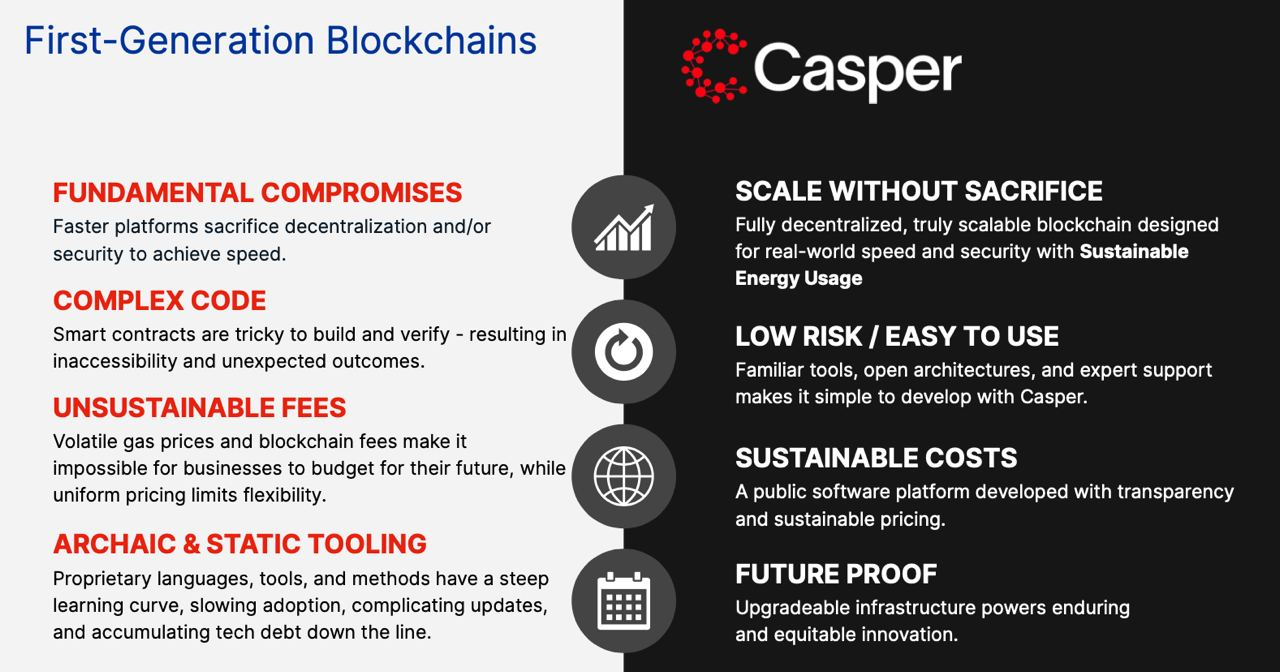
Lucky Q6. The Casper Mainnet launched on March 31st of last year, so it’s been live for about 16 months. Ralf can you tell us a little about the usage on and growth of the network?
Ralf Kubli: Well, here are some relvant statistics as of this week…
Total Wallets/Accounts: 83,344
Delegators: 18,059
Connected Nodes: 202
Validators: 100
Total Token Transfers: 526,405
Circulating Supply: 5.925B CSPR
Total Supply: 11.11B CSPR
Total Staked: 8.2B CSPR (74% of Total Supply)
In addition to network activity, we have a robust, thriving community, with 30K+ developers in our Discord Channel, 180K+ followers on Twitter and 100K+ on Telegram. I encourage all of you to join the following:
1) The Casper Discord Channel (especially if you’re a developer): https://discord.com/invite/Q38s3Vh
2) Casper’s main TG channel: https://t.me/casperblockchain, and
3) Casper’s Twitter account: https://twitter.com/Casper_Network
hope to see you on one of these channels!!
Lucky Q7. Back over to you, @CryptoEscobar You’ve spoken about Casper being an enterprise-grade blockchain. Can you explain a little more about what you mean and give some examples of enterprises who are building on chain?
Cliff Sarkin: That’s a great question. Thank you for asking it. When we say “enterprise-grade,” we don’t mean Casper is a blockchain only for large companies. What we mean is that we have built – and continue to improve – a robust, public layer 1 chain that companies, governments, and orgnaizations (of all sizes) will use to build real world solutions. Even a developer that wants to build a real business using blockchain, should do so on Casper.
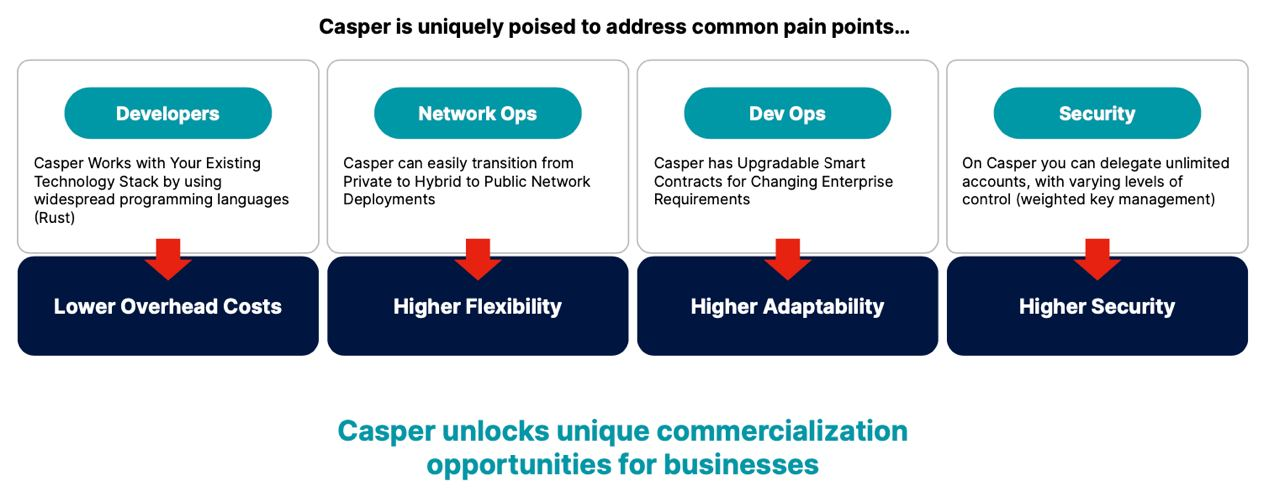
Businesses need capabilities in the protocol that will support their needs, such as control over contract code on chain (upgrades), ESG Compliance, Interoperability with their existing Web2 development tooling, consistent transaction costs along with customer support and professional services to help train their developers and ensure that their project is completed. We remember what happened when Cloud and the Internet were adopted – and what was needed for Enterprise adoption.
In addition, enterprise will eventually be the largest use case – and by far the biggest market – for blockchain technology. We know that it will take time for the market to mature, but it will be a much more stable revenue and usage growth. As the image below image shows, CIOs and CTOs of leading companies say they will spend 10s of billions of dollars on Blockchain infrastructure in the coming 5-10 years and we are uniquely positioned to take significant market share.
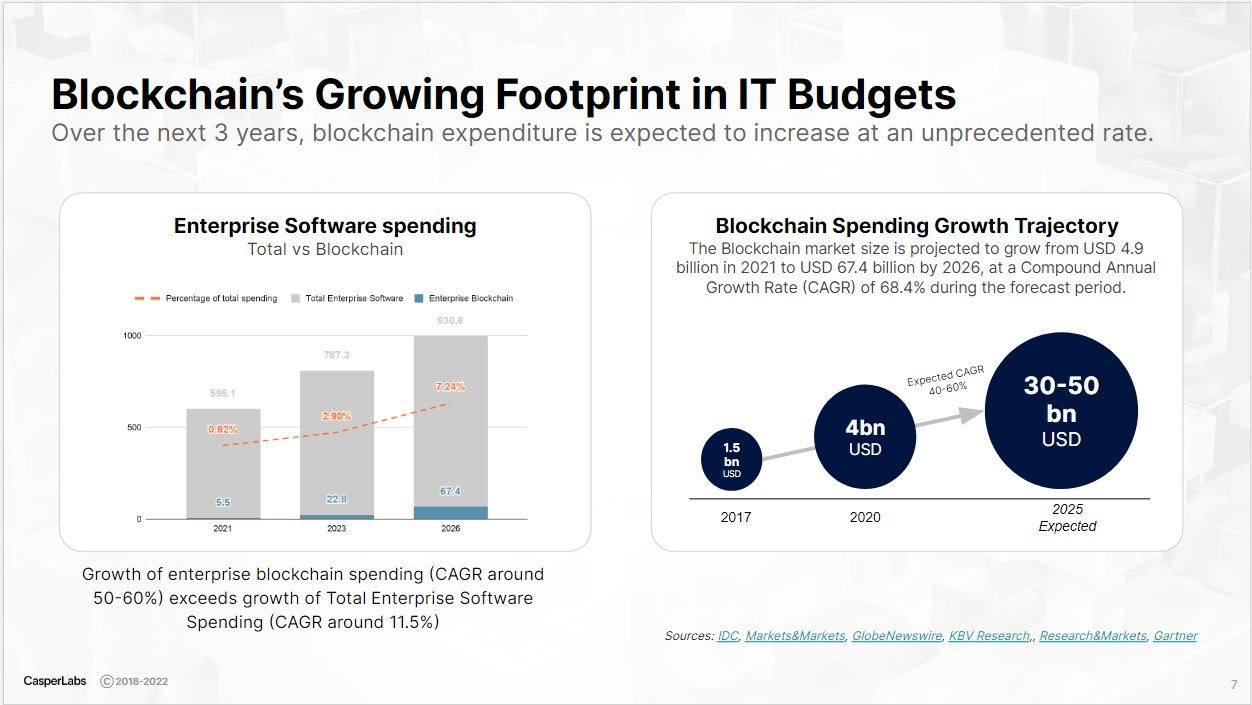
We are in active conversations with many Fortune 500 companies, and as these projects come to fruition, we will make announcements. Here are some examples of such enterprises already building on Casper:
IPwe (https://ipwe.com/) – CasperLabs has built an NFT-based chain of custody solution for IPwe’s public patent records on the Casper public blockchain. Patents are created and securely stored as NFTs, so that they are traceable and tradable.
Metacask (https://metacask.com/) – Metacask sought to modernize the high-end whisky market by creating an innovative new business model that would democratize the market and provide access to new growth audiences. CasperLabs translated this bold ambition into a seamless user experience by building NFTs representing whisky casks, and enabling investors to begin acquiring or selling whisky casks on our new digital platform within the same day.
WISeKey (https://www.wisekey.com/), Wise.Art (https://platform.wise.art/), and WISeSat (https://www.wisekey.com/wisesat/) – WISeKey is a publically traded digital security company (NASDAQ: WKEY), using the Casper Network for their NFTs. One great use is the WISeSat.Space constellation, launched with SpaceX, that enables the direct connection of satellites to IoT devices. WISeKey will soon have so many satellites in orbit that data from IoT devices anywhere on earth can be saved and protected on the blockchain.
DMusic (https://dmusic.io/) – Dmusic works with some of the biggest names in the music world. These artists are innovators who want to create uniquely valuable experiences for their fans. In partnership with Haute Living and Megalodon, Dmusic’s bold ambition is to simplify the music industry, transforming artists into platforms that enable music lovers to connect in entirely new ways with their favorite artists, and even share in revenue creation. And those are just a few!
To learn more about use cases on Casper, you can go to https://casperlabs.io/success-stories
Lucky Q7. @rrkubli the association also has stated Capital Markets as an area that is important. What is the Association doing in this area?
Ralf Kubli: The Casper Association is looking to enable a true open source and open access for the kind of technology which will enable financial innovations on blockchains. This can be DeFi but also other financial applications which will be enabled by blockchain.
We strongly believe that only Smart Financial Contracts (SFCs) built on the open source ACTUS standard will provide the basis for consistency, interoperability, and scalability of blockchain based financial solutions. This includes SFCs based on ACTUS open source standard for TradFi, systemically relevant Blockchain financial solutions with SFC, institutional grade DeFi with the security (and speed) required by Financial Markets, and DeFi projects that want the decentralization and security of Ethereum, yet predictable low cost fees and upgradability of contracts, are building on Casper.
Lucky Q8. @CryptoEscobar Cliff what does Casper’s roadmap currently look like? How does Casper adapt to changes in this fast-paced ecosystem in terms of roadmap prioritization.
Cliff Sarkin: I am super excited about what’s on the horizon for Casper, thank you for asking @Luckylllll. Coming up soon is release 1.5 and then a major network update in Casper 2.0.
So, with upgrade 1.5, it will be easier for new nodes to join the network. It also has a lot of interesting features, such as redelegate. 1.5 will reduce disk usage, making nodes easier and cheaper to run. This makes the network more robust and secure – because running a validator is more affordable. Additionally, there is a groundbreaking feature called “speculative execution” that will allow contracts to be debugged and tested against mainnet!
Casper 2.0, anticipated for early 2023, will dramatically improve performance with another new consensus protocol (codename Zug), provide new capabilities for smart contracts as well as an exciting new gas fee mechanism. Examples are contracts that can pay for themselves, contracts that can stake the network and contracts that can have delegated keys for upgrades. In addition, Casper 2.0 will include faster block times, and improved engineering velocity.
As a public netwotk, our roadmap is always available, here at: https://github.com/casper-network/roadmap/projects/2
Lucky Q9. ❇️One last question, and this one is for both of you… What about Casper are you most excited about right now?
Cliff Sarkin: Among the many things I’m excited about – and we touched on many of them here, today – I am particularly proud of the recent PARTNERSHIPS we have begun.
Here are a few to highlight…
China – The vision of China’s Blockchain-Based Services Network (BSN) is to bring low-cost, efficient, and flexible blockchain development environments to government departments, businesses, and developers. BSN asked CasperLabs to create an adaptation of Casper that would meet very specific local needs which will be called the Chengdu Chain, expected to go live in the next several weeks.
India – CasperLabs is developing another “open, permissioned network” based on the Casper Technology for implementation of Government of Telangana Blockchain initiatives. Telangana’s adoption of blockchain technology will empower policy makers and government officials to facilitate more sustainable, efficient and secure government processes while simultaneously opening up new entrepreneurship opportunities for both private and public sectors. For more, please see: https://www.businesswire.com/news/home/20220524005984/en/CasperLabs-to-Provide-Open-Permissioned-Network-for-Implementation-of-Government-of-Telangana-Blockchain-Initiatives
IBM – We at CasperLabs recently deepend our partnership with IBM, having co-built the first atomic cross-chain swap of fungible and non-fungible tokens between an instance of a Hyperledger Fabric private network and the Casper Blockchain. The swap is modeled using the HTLC protocol and implemented using CasperLabs’ smart contract SDK, TypeScript SDK and Linux Foundation’s Hyperledger Labs Weaver: DLT Interoperability Framework at https://labs.hyperledger.org/weaver-dlt-interoperability/. The technology enabling secure swaps between potentially different classes of tokens residing on different networks. For more, please see IBM’s blog post about the partnership: https://www.ibm.com/blogs/blockchain/2022/05/hybrid-networks-ibm-blockchain-services-casperlabs-davos-2022/
SmartMedia Labs – We have partnered with a leading Web3 & NFT platform SmartMedia Technologies and its network partner, BLOCKv, which will allow enterprise users to rapidly design, develop and deploy programmable “Smart NFTs” using the SmartMedia self-serve, no-code, drag-and-drop NFT studio. To learn more, please visit https://casperlabs.io/blog/breakthrough-moment-for-nft-adoption
And more partnerships to be announced by CasperLabs soon.
Over to you @rrkubli…
Ralf Kubli : Wow, this is a great question. And it’s a bit of a difficult one, since we at the Casper Association are excited about so many things happening on Casper, like DeFi (bridges, swaps, DEXs, AMMs, and liquidity pools), NFT use cases and NFT marketplaces, developer tools and onboarding, events & conferences, and so much more. But if I were to say the most exciting thing right now, it would be COMMUNITY.
Casper has a thriving global community, and it continues to grow is size and passion. Every person – whether he or she is a developer, entruprenuer, partner, validator, delegator, supporter, or token holder – makes up the backbone of who we are and what we do.
MEXC has been part of our community since mainnet launch, and I am very excited to be strengthening our connection this week and welcoming even more MEXC community members into the Casper family. We invite and welcome all of you to join the Casper Network and be a part of what we are all building together.
Free-asking Session
Q1. Where is the headquarters of CSPR? @Ehanq1
Ralf Kubli :
the Headquarters are in Zug Switzerland. Many projects are here and the community is very exciting
Q2. @maticboi asked “Despite having a tight and secured platforms, security will always be a topmost concern for users. What can CSPR guarantee or promise when it comes to security and privacy of its users?”
Cliff Sarkin :
This is a really good question and very relevant for Casper. In the pursuit of throughput, many protocols have sacrificed security. A blockchain must not sacrifice security for performance. What we have found with our enterprise clients is that security is valued more than performance.
And thus, for Casper, security is of the highest priority.
For more, pls see this blog post: https://casperlabs.io/blog/setting-a-new-security-standard-for-public-proofofstake-bl
and this one: https://casper.network/blog/security-security-security-inside-the-initiative-that-led
Q3. What are the key considerations when delegating tokens to a validator? @barbarkeanan:
Ralf Kubli :
good question. Not always the biggest validators are relevant. One should consider length on the network, uptime, how many times they won the auction to be a validator, etc.
Q4. @hoangiah asked “I see a lot of blockchains working very good on enterprise development that have come before Casper. What special about Casper to compete with these platforms?
Cliff Sarkin :
Well, Hyperledger Fabric & Corda are enterprise-focused chains but only permissioned versions and lacking critical features which Casper has built. Hedera Hashgraph is enterprise-focused but highly centralized and permissioned; what’s more, its liveness is only statistical, not provable.
Casper is unique in that it is the first provably live and provably safe version of CBC Casper ever built. In that way, it is arguably the only fully decentralized, highly secure, and scalable Proof of Stake blockchain – one that does not sacrifice security for performance.
Q5. @cengizhantekin asked “What kind of applications are to be built by using CasperLabs? Can you provide some example projects who use Casper infrastructure?”
Cliff Sarkin :
IPwe (https://ipwe.com/) – CasperLabs has built an NFT-based chain of custody solution for IPwe’s public patent records on the Casper public blockchain. Patents are created and securely stored as NFTs, so that they are traceable and tradable.
Metacask (https://metacask.com/) – Metacask sought to modernize the high-end whisky market by creating an innovative new business model that would democratize the market and provide access to new growth audiences. CasperLabs translated this bold ambition into a seamless user experience by building NFTs representing whisky casks, and enabling investors to begin acquiring or selling whisky casks on our new digital platform within the same day.
WISeKey (https://www.wisekey.com/), Wise.Art (https://platform.wise.art/), and WISeSat (https://www.wisekey.com/wisesat/) – WISeKey is a publically traded digital security company (NASDAQ: WKEY), using the Casper Network for their NFTs. One great use is the WISeSat.Space constellation, launched with SpaceX, that enables the direct connection of satellites to IoT devices. WISeKey will soon have so many satellites in orbit that data from IoT devices anywhere on earth can be saved and protected on the blockchain.
DMusic (https://dmusic.io/) – Dmusic works with some of the biggest names in the music world. These artists are innovators who want to create uniquely valuable experiences for their fans. In partnership with Haute Living and Megalodon, Dmusic’s bold ambition is to simplify the music industry, transforming artists into platforms that enable music lovers to connect in entirely new ways with their favorite artists, and even share in revenue creation.
Trying to find MEXC AMAs recaps?
It’s easy! Explore them in a special section of our MEXC blog. Find insights for other recently listed projects at MEXC
Join MEXC and Get up to $10,000 Bonus!
Sign Up